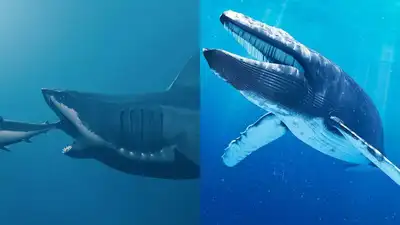ARTICLE AD BOX

The idea of a battle between a megalodon and a blue whale captures the imagination, though these giants never shared the same oceans. The megalodon, an extinct apex predator, was equipped with enormous jaws, 250 teeth, and one of the most powerful bites in history, while the blue whale is the largest creature ever, weighing over 100 tons and stretching more than 100 feet.
Size alone gives the whale an advantage, but speed, predatory instincts, and offensive capabilities make the megalodon a formidable contender. Comparing their physical attributes, movement, senses, and defenses reveals how these ocean titans might have fared in a hypothetical encounter.
Megalodon vs. Blue Whale: Comparing physical attributes
A fight between a megalodon and a blue whale is fascinating, though these giants never coexisted. The megalodon, an extinct apex predator, could reach up to 67 feet in length and weigh around 50 tons.
In contrast, the blue whale is the largest creature to have ever lived, stretching over 100 feet and weighing more than 100 tons. In terms of sheer size, the blue whale clearly has the upper hand. However, the megalodon was equipped with incredible bite power, estimated at 41,000 pounds per square inch, and rows of 250 teeth, giving it a deadly offensive capability that no blue whale possesses.Speed and movement also differ: megalodons swam at approximately 11 mph using side-to-side tail movements, while blue whales cruise at around 5 mph, reaching bursts of 20 mph with up-and-down tail strokes.
The megalodon’s senses were finely tuned for hunting, including an acute sense of smell, excellent low-light vision, and an electrical detection system, whereas blue whales rely mostly on hearing and have limited sight and smell.
Defensive and offensive capabilities in a potential fight between Megalodon and Blue Whale
When considering defenses, the blue whale’s massive body, thick blubber, and powerful tail thrashes provide significant protection. Megalodons, although large and fast, lacked the same defensive advantages.
Offensively, the megalodon was far superior: massive jaws, sharp teeth, and predatory instincts made it a stealthy ambush predator capable of overpowering most ocean creatures. Blue whales primarily rely on speed and tail strikes to defend themselves, with no true weaponry to match a megalodon’s bite.Predatory behaviour is another key factor. Megalodons hunted mid-sized whales and large fish using speed and surprise, whereas blue whales are peaceful filter feeders, consuming krill and other small marine creatures.
In a hypothetical encounter, the megalodon’s predatory experience and lethal attack methods would likely give it a decisive advantage.

Who would win in a fight: Megalodon or Blue Whale
Based on size, speed, senses, and combat prowess, the megalodon would have the upper hand in a direct confrontation. Sharks today, including great whites, have been observed hunting whales much larger than themselves by targeting vulnerable areas and using repeated bites. Extrapolating this to megalodon, it would strike first, inflict damage, and evade counterattacks, gradually wearing down a blue whale.
Although the blue whale could land disorienting tail hits or flee short distances, its lack of offensive weaponry makes it unlikely to prevail in a prolonged battle against the shark.Historical comparisons also suggest that the megalodon’s strategy would focus on stealth and patience, striking repeatedly until the whale became exhausted or succumbed to blood loss. Size alone would not save the blue whale in this scenario, as the megalodon was specifically equipped for such predatory encounters.
Other apex predators and why Megalodon is extinct

While no modern creatures match the megalodon’s hunting power, ancient oceans held other titans like the Livyatan, a prehistoric sperm whale with teeth over a foot long. Livyatan could rival a megalodon in size and strength, using echolocation and sheer force to dominate the seas. Despite this, the megalodon’s senses and ambush tactics gave it an edge over most prey.Megalodons are extinct today, with climate change and shifting ocean levels likely playing a key role. Warm-water habitats shrank during the Pliocene, reducing prey availability. If megalodons still existed, their massive teeth would litter ocean floors and their presence would drastically alter marine ecosystems. While blue whales dominate today’s oceans, the megalodon remains the apex predator of its era, fully equipped to take down nearly any opponent in its path.Also Read: Eagles vs hawks in the wild: Difference in appearance, hunting styles, and habits



.png)
.png)
.png)
















 1 day ago
7
1 day ago
7








 English (US) ·
English (US) ·